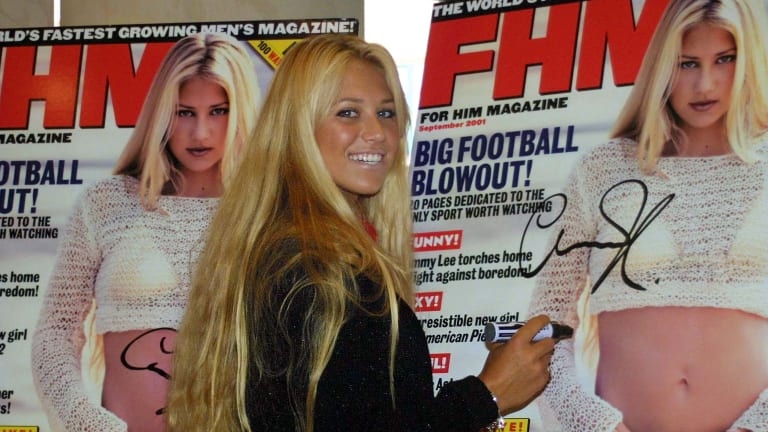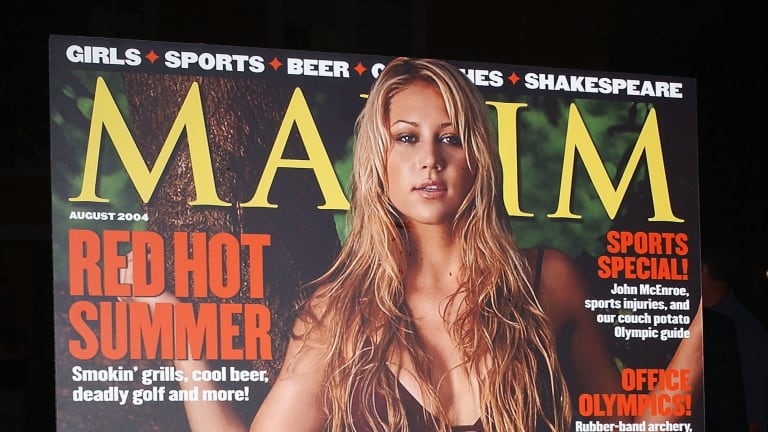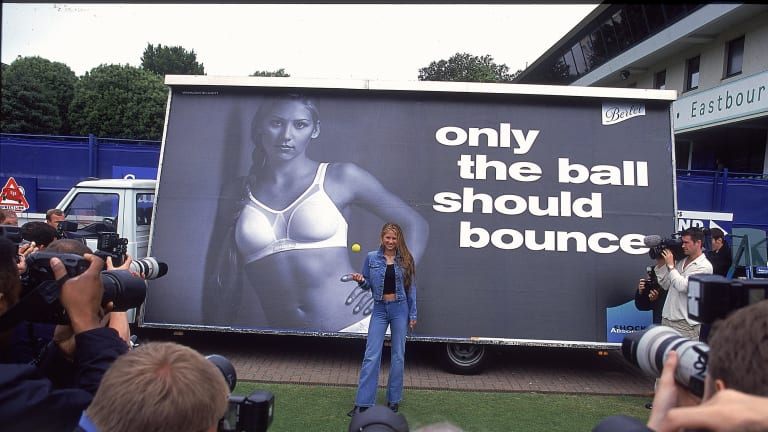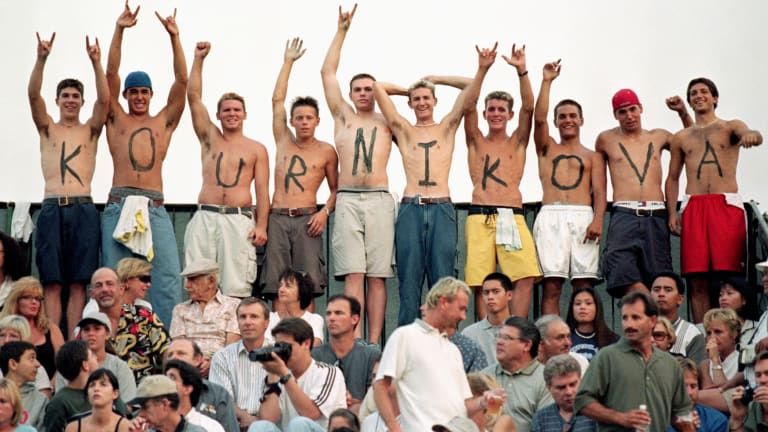What Framing Britney Spears tells us about the saga of Anna Kournikova
By Steve Tignor Feb 18, 2021Which Indian Wells champ will have the better year: Jack Draper or Mirra Andreeva?
By TENNIS.com Dec 24, 2025Carlos Alcaraz tops ATP prize money leaders for 2025 with over 21 million dollars
By John Berkok Dec 24, 2025Elise Mertens had her best season in years in 2025, but you may not have noticed
By John Berkok Dec 24, 2025Five days, a dozen looks: Inside Venus Williams' Palm Beach wedding bash
By TENNIS.com Dec 24, 2025Anna Kournikova welcomes fourth child with Enrique Iglesias
By TENNIS.com Dec 23, 2025Who is more likely to win a Slam: Amanda Anisimova or Elena Rybakina?
By TENNIS.com Dec 23, 2025Alejandro Davidovich Fokina's season was one to remember, even if he may opt to forget
By Ed McGrogan Dec 23, 2025Carlos Alcaraz keeps his promise with New York City tattoo tribute
By TENNIS.com Dec 22, 2025Fabio Fognini finishes third on Italy's 'Dancing with the Stars': "It wasn't just a dance"
By TENNIS.com Dec 22, 2025What Framing Britney Spears tells us about the saga of Anna Kournikova
If Kournikova were playing and struggling today, there would be ogling and mockery. But she would likely have her defenders in the press and on social media, and hopefully she wouldn't be marketed or written about like it’s 1999.
Published Feb 18, 2021
Advertising
Nestled between January's summer swing of tournaments in Australia, and March's Sunshine Double in the U.S., February can be overlooked in tennis. But not in 2021, with the Australian Open's temporary move to the second and shortest month of the calendar. Beyond that, February is Black History Month, and also a pivotal time for the sport in its rebound from the pandemic.

What Framing Britney Spears tells us about the saga of Anna Kournikova
Advertising
To commemorate this convergence of events, we're spotlighting one significant story per day, all month long, in The 2/21.
An hour or so into Framing Britney Spears, the new documentary about the pop singer, I had a flashback. It came during one of the many scenes from the mid-2000s where Spears, who was being hounded 24/7 by the tabloids at the time, is asked by a TV anchor whether she thinks she’s fit to be a mother and a role model.
The sight of Spears, leaning forward, face pinched in subdued forbearance, took me back to another encounter between the media and a less-than-pleased young female star from around the same time. The woman was Anna Kournikova, the site was the US Open interview room, and the year was 2002. Kournikova had just put on a disastrous performance in Louis Armstrong Stadium, losing 6-3, 6-0 to Angelique Widjaja, a player who would never crack the Top 50.
As always when Kournikova played, there was an overflow crowd and a ravenous atmosphere in the arena. The Russian was the most famous, the most endorsed, the most ogled, the most mocked, and the most searched-for female athlete in the world at the time, but she had missed the Open the previous year with a stress fracture in her foot, and had failed to get past the first round at the French Open and Wimbledon in 2002. A loss on this day would bring her season to a depressingly futile conclusion.
There were plenty of Kournikova fans in the crowd, but there was also an undercurrent of merciless scrutiny, of an audience waiting for the starlet to stumble off the stage. Kournikova obliged with a stream of double faults and bad decisions, in a match that got worse for her with each game.
“I made, like, a million mistakes,” Kournikova said afterward. “I don’t think it was a pretty match for anyone—especially for me.”
An admirably blunt assessment, but she wasn’t going to get off that easily. After every failure on the court, Kournikova had to answer for her financial success off of it. One questioner asked, “You’ve obviously read your press clippings over the years, ‘She gets great endorsements but doesn’t earn on the court.’ Does that add pressure?” Another pointed out that she had bounced a few of her serves in front of the net. Another wondered, “Do you feel you work hard enough?” Near the end, someone asked, “Do you worry about it from the business point of view, that the lack of tournament victories will cost the endorsements, maybe the photographers won’t show up anymore?”
“Oh good!” Kournikova snapped. “Good if they don’t show up anymore.”

What Framing Britney Spears tells us about the saga of Anna Kournikova
© Getty Images
Advertising
Kournikova walks off the court, toward a throng of onlookers, after a one-sided loss to unheralded Angelique Widjaja at the 2002 US Open. (Getty Images)
Kournikova was just 21, but this would be her final match at the US Open. By then, you could almost believe that she really was sick of the photographers and the attention; of being The Woman Who Never Won a Tournament; of the wolf whistles that broke out every time she took off her warm-up jacket; of the lad-mag articles with headlines like “She’s Grand Slammin’”; of the boys in front rows who called out between points, “Pretty smile now, Anna”; of having a poker hand named after her because it “looked good but didn’t win much.”
Spears and Kournikova were both born in 1981, and both became famous as teenagers in the late 90s. Kournikova reached the Wimbledon semifinals in 1997, and Spears’ breakout song, “Hit Me Baby One More Time,” was released in 1998. They arrived at an especially media-saturated moment, when tabloid culture was reaching its peak in the U.S., and the Internet was making its presence felt for the first time.
Framing Britney Spears reminds us that this was also the era of the Clinton-Lewinsky scandal, which brought a new level of frank prurience to the public sphere. As the Washington Post’s Ashley Fetters wrote last week, “The media—both the tabloids and more credible high-profile outlets—hounded women like Spears for disturbingly intimate details of their lives, then belittled and even villainized them for those very details.” Spears claimed to be a virgin, as did Kournikova. Or, as Newsweek put it in an article entitled “The Virgin Teen Queen" in 1999: “She wears the skimpiest clothes and sports the brawniest boyfriend in tennis, but Anna Kournikova, 18, insists she’s as pure as her tennis whites. ‘I do not let anyone even have a peep in my bed,’ the Russian vixen said.”
From the start, Kournikova was a subject for men’s magazines and the entertainment press rather than the sports pages. An Internet site began a countdown to her 18th birthday. People put her in its “50 Most Beautiful” list when she was 16. FHM named her the “Sexiest Woman in the World” a few years later. But the more she was hyped for her looks, the more she was bashed for being overhyped as a tennis player. ESPN included her in its list of the biggest flops of the last 25 years, and named her, at one point, the most overrated athlete in history.
“Her fame now seems oddly singular, the product of a time when every dude had a stack of Maxims in his bathroom,” Jay Caspian Kang wrote in Grantland in 2012. “Kournikova was held up as proof that men could take a completely unremarkable yet thoroughly hot tennis player and use her as an excuse to never say one serious word about women’s sports.”

What Framing Britney Spears tells us about the saga of Anna Kournikova
© Getty Images
Advertising
At the Virgin Megastore in New York City for an FHM magazine signing, 2000. (Getty Images)

What Framing Britney Spears tells us about the saga of Anna Kournikova
© 2004 Getty Images
Advertising
A giant-sized cover of Maxim magazine at Sobe's "Tale Slide" Party in Hollywood, 2004. (Getty Images)
The lad magazine worldview spread during those years, and the WTA’s sex appeal was promoted. The Sony Ericsson Open in Miami ran an ad campaign featuring a shot of Kournikova above the tagline, “Come See Anna’s Serves and Curves.” At Tennis Magazine, we titled one of our WTA season previews, “The Bold and the Beautiful.” New York’s 2001 feature on the tour was called “Riot Girls.” (First line: “Jennifer Capriati is hot.”) In 2000, Sports Illustrated ran a cover shot of Kournikova lying on a pillow, and opened its feature on her with this subhead: “She won’t win the French Open, but who cares? Anna Kournikova is living proof that even in this age of supposed enlightenment, a hot body can count as much as a good backhand.”
Kournikova wasn’t just an innocent victim of her times. Looking back, she probably didn’t have to appear in a campaign for a line of bras with the slogan, “Only the Balls Should Bounce.” She probably could have turned down an appearance fee or two at a big event and won more matches—and even a title—at lower-tier tournaments. And she probably could have been easier to work with. In Venus Envy, his book on the WTA’s riot-girl days, Jon Wertheim describes a scene at a photo shoot in which a photographer reaches for a new lens and tells Kournikova, “Just hold on a second and we’ll make you beautiful.” To which she replies, “I already am beautiful. Just take the picture.”

What Framing Britney Spears tells us about the saga of Anna Kournikova
© Getty Images
Advertising
In Eastbourne for a Berlei Shock Absorber Bra ad campaign, 2000. (Getty Images)
The rap on Kournikova was that she let her pursuit of fame and endorsement money distract her from her training. Looking at her outstanding junior résume—she won the Orange Bowl 18s as a 14-year-old, was the No. 1 junior in the world, and came with the Nick Bollettieri seal of approval—that seemed like a logical assumption. But Kournikova herself always adamantly denied it.
“I’m not involved in a lot of stuff like you guys say,” she said when she was asked about her “extracurriculars” at Wimbledon in 2002. “It’s 99 percent less of what everybody else says that I do.”
Were the criticisms legitimate? Her doubles partner and most famous frenemy, Martina Hingis, criticized her work ethic at one point. But at the same time, Kournikova was willing to hire Harold Solomon, a coach universally described as “no-nonsense,” to help her mount a comeback after her 2001 stress fracture.
The reasons for her demise were likely duller, and out of her control. There were the injuries to her back and spine, which forced her off the tour at 22. There was her size; she was 5’8” at a time when top women like Lindsay Davenport and Venus Williams were six feet or taller. There was her technique; Bollettieri said he regretted that his coaches were never able to develop a “killer forehand” for her.

What Framing Britney Spears tells us about the saga of Anna Kournikova
© Getty Images
Advertising
Bollettieri and a young Kournikova, in Bradenton, Fla. (Getty Images)
There were her nerves; Kournikova was a shotmaker—Solomon called her an artist with a racquet—but she lacked the steeliness of her much more successful successor, Maria Sharapova. There was the feverish scrutiny that came with every match she played. And there was her age. At a time when Serena and Roger Federer are still in the thick of things at 39, it can be hard to believe that the saga of Anna Kournikova the tennis player was over so quickly. She never had a change to grow up, and presumably mature, in public, the way the pros do today.
Kournikova wasn’t the last woman tennis player to receive outsized attention for her looks. Even as Sharapova was winning the US Open in 2006, she was starring in a Nike ad with the theme song, “I Feel Pretty.” Ana Ivanovic drew similarly intense overflow crowds to her matches. In 2014, Eugenie Bouchard inspired a rowdy fan club at the Australian Open, and made the cover of the New York Times Magazine with the headline, “Genie Bouchard could be the future of women’s tennis. All she has to do is win.”
Sex and sexism haven’t been banished from the sport, and hottest-athlete lists aren’t going away anytime soon. But 2021 doesn’t feel like 2001, or even quite like 2014. These days Serena’s accomplishments and impact are compared with those of all-time sporting heroes like Muhammad Ali. Naomi Osaka shows up in fashion magazines, but her best-known clothing statements are the masks she wore at last year’s US Open to memorialize African-Americans killed by law enforcement. At 16, Coco Gauff has already proven to be an eloquent spokesperson on social issues. Instagram has given players a way to control their stories and images in ways their predecessors couldn’t. If Kournikova were playing and struggling today, there would be ogling and mockery. But she would likely have her defenders in the press and on social media, and hopefully she wouldn't be marketed or written about like it’s 1999.
There are worse fates than Kournikova’s. She made a lot of money because of tennis, she’s married and has three children, and she doesn’t seem to suffer from the same bizarre family circumstances as Spears. When I think about Kournikova’s career 20 years later, two polar-opposite moments come to mind, both from the US Open.

What Framing Britney Spears tells us about the saga of Anna Kournikova
© Getty Images
Advertising
Getty Images
During a night match in Ashe Stadium, a group of young males appeared in the upper reaches of the arena, wearing T-shirts that spelled out “K-O-U-R-N-I-K-O-V-A.” On changeovers, they bounced up and down and chanted her name. Kournikova wasn’t playing in the match, she wasn’t on the schedule that night, and, unless my memory is faulty, she wasn’t even in the tournament that year. But that didn’t stop them from chanting for her.
The second memory comes from the much smaller, now demolished, Grandstand court. Jay Caspian Kang described Kournikova as a “completely unremarkable player” in Grantland. That wasn’t true of her doubles game, which was creative and fun to watch. She won two Australian Opens and two tour championships with Hingis, was ranked No. 1 in doubles, and reached the finals of two Slams in mixed. Freed from the anxieties that come with putting yourself on the line in singles, Kournikova could show off the shots that so often failed her when she was on her own. Tennis is a lonely game for most players, but that seemed doubly true for the woman who was by herself at the center of so much attention.
On this afternoon in the Grandstand she wasn’t alone; she was playing a mixed-doubles match. The front rows were filled with the usual gawkers and leerers, who leaned as far into the court as possible. But the atmosphere was relaxed, and so was Kournikova, who traded smiles and high-fives with her partner (I think it was Max Mirnyi), and seemed happily oblivious to the scene around her. It showed in her play: She didn’t double fault, she held her own on returns and finished points at net, and she hit passing-shot winners. She and her partner, to the delight of the audience who cheered every good play she made, walked off winners.

What Framing Britney Spears tells us about the saga of Anna Kournikova
© Getty Images
Advertising
Getty Images